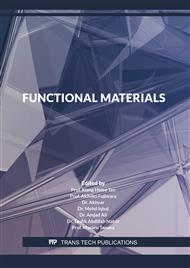[1]
D. Perremans, E. Trujillo, J. Ivens, A.W. Van Vuure. Effect of discontinuities in bamboo fibre reinforced epoxy composites. Composites Science and Technology. 2018; 155: 50-57.
DOI: 10.1016/j.compscitech.2017.11.033
Google Scholar
[2]
Jianyong Lin, Zexun Yang, Xiaoxia Hu, Gonghua Hong, Shuangbao Zhang, and Wei Song. The Effect of Alkali Treatment on Properties of Dopamine Modification of Bamboo Fiber/ Polylactic Acid Composites. Polymers. 2018; 10.
DOI: 10.3390/polym10040403
Google Scholar
[3]
Linhua Zou, Helena Jin, Wei-Yang Lu, Xiaodong Li. Nanoscale structural and mechanical characterization of the cell wall of bamboo fibers. Materials Science and Engineering C. 2009; 29: 1375-1379.
DOI: 10.1016/j.msec.2008.11.007
Google Scholar
[4]
Haiyang Zhang, Jin Liu, Zhiqiang Wang, Xiaoning Lu. Mechanical and thermal properties of small diameter original bamboo reinforced extruded particleboard. Materials Letters. 2013; 100: 204-206.
DOI: 10.1016/j.matlet.2013.03.028
Google Scholar
[5]
Kin-tak Lau, Pui-yan Hung, Min-Hao Zhu, and David Hui. Properties of natural fiber composites for structural engineering applications. Composites Part B. 2018; 136: 222-233.
DOI: 10.1016/j.compositesb.2017.10.038
Google Scholar
[6]
G.Wang and F.Chen. Development of bamboo fiber-based composites. Advanced High Strength Natural Fiber Composites in Construction. 2017;10: 235–253.
DOI: 10.1016/b978-0-08-100411-1.00010-8
Google Scholar
[7]
Kim L. Pickering. Properties and performance of natural-fibre composites. (2008).
Google Scholar
[8]
A.R. Horrocks and D.Price Fire retardant materials. (2001).
Google Scholar
[9]
Dagang Liu, Jianwei Song, Debbie P. Anderson, Peter R. Chang, Yan Hua. Bamboo fiber and its reinforced composites: structure and properties Cellulose. 2012; 19: 1499-1480.
DOI: 10.1007/s10570-012-9741-1
Google Scholar
[10]
Yan Yu, Hankun Wang, Fang Lu, Genlin Tian, Jinguo Lin. Bamboo fibers for composite applications: a mechanical and morphological investigation. J Mater Sci. 2014; 49: 2559-2566.
DOI: 10.1007/s10853-013-7951-z
Google Scholar
[11]
Krishan K. Chawla. Fibrous Materials. (2016).
Google Scholar
[12]
Diana P. Ferreira, Juliana Cruz, and Raul Fangueiro. Surface modification of natural fibers in polymer composites. Green Composites for Automotive Applications. 2019; 3-33.
DOI: 10.1016/b978-0-08-102177-4.00001-x
Google Scholar
[13]
J. Kaima, I. Preechawuttipong, P. Jongchansitto and N. Charoenloe. Effect of Chemical Solution on Tensile Strength of Bamboo Fiber. Materials Science and Engineering. 2020; 886: 012061.
DOI: 10.1088/1757-899x/886/1/012061
Google Scholar
[14]
Eylem D. Tomak, Elif Topaloglu, Esat Gumuskaya, Umit C. Yildiz, Nurgul Ay. An FT-IR study of the changes in chemical composition of bamboo degraded by brown-rot fungi International Biodeterioration & Biodegradation. 2013; 85: 131-138.
DOI: 10.1016/j.ibiod.2013.05.029
Google Scholar
[15]
H.P.S. Abdul Khalil, I.U.H. Bhat, M. Jawaid, A. Zaidon, D. Hermawan, Y.S. Hadi. Bamboo fibre reinforced biocomposites: A review. Materials and Design. 2012; 42: 353-368.
DOI: 10.1016/j.matdes.2012.06.015
Google Scholar
[16]
Parnia Zakikhani, R. Zahari, M.T.H. Sultan, D.L. Majid. Materials and Design. 2014; 63: 820-828.
DOI: 10.1016/j.matdes.2014.06.058
Google Scholar
[17]
Kazuya Okubo, Toru Fujii, and Yuzo Yamamoto. Development of bamboo-based polymer composites and their mechanical properties. Composites Part A. 2004; 35: 377-383.
DOI: 10.1016/j.compositesa.2003.09.017
Google Scholar
[18]
Ge Wang, Yan Yu, Sheldon Q. Shi, Jinwu Wang, Shuangping Cao, Haitao Cheng. MICROTENSION TEST METHOD FOR MEASURING TENSILE PROPERTIES OF INDIVIDUAL CELLULOSIC FIBERS. Wood and Fiber Science. 2011; 43: 251-261.
Google Scholar
[19]
Zhuo-Ping Shao, Chang-Hua Fang, Sheng-Xia Huang, Gen-Lin Tian. Tensile properties of Moso bamboo (Phyllostachys pubescens) and its components with respect to its fiber-reinforced composite structure. Wood Sci Technol. 2010; 44: 655-666.
DOI: 10.1007/s00226-009-0290-1
Google Scholar
[20]
O.P. Balogun, J.A. Omotoyinbo, K.K. Alaneme, I.O. Oladele, B.J. Babalola. The effect of chemical treatment on tensile properties of soil retted entada mannii fibres Ameican. Journal of Engineering Research (AJER). 2015; 4: 168-175.
Google Scholar
[21]
Flàvia1 P. Morais, Raquel A.C. Bértolo, Joqnq M.R. Curto, Maria E.C.C. Amaral, Ana M.M.S. Carta, Dmitry V. Evtyugin. Characterization data of pulp fiber performance in tissue paper application. Data in brief. 2020; 29: 105253.
DOI: 10.1016/j.dib.2020.105253
Google Scholar
[22]
Roberto Aguado, Ana Moral, Patricio López, Pere Mutjé, Antonio Tijero. Morphological analysis of pulps from orange tree trimmings and its relation to mechanical properties. Measurement. 2016; 93: 319-326.
DOI: 10.1016/j.measurement.2016.06.063
Google Scholar



